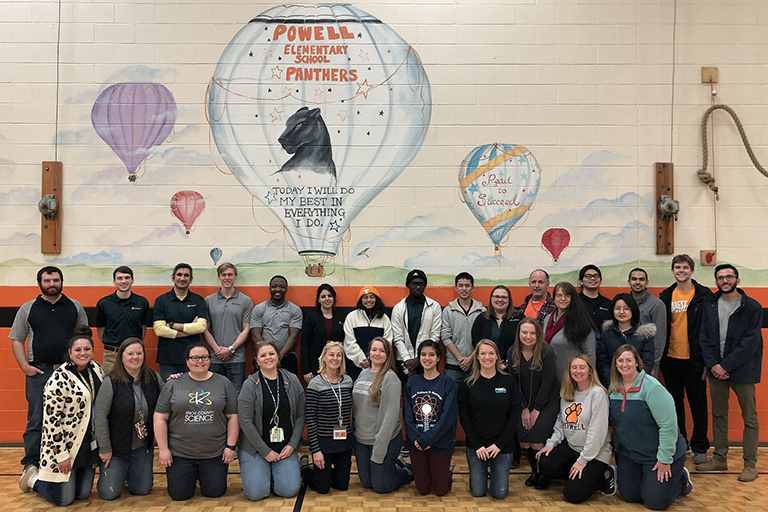
UT students in Powell Elementary School, including NE students Robby Kile, back row, far left; Alyssa Hayes, front row, fifth from right; and Emily Hutchins, front row, sixth from right.
Nuclear engineering doctoral student Alyssa Hayes loves doing outreach in schools, so she volunteered to be the outreach coordinator for the Nuclear Engineering Graduate Student Association (NEGSA).
Eventually, she met Anne Skutnik, Education Coordinator for the Center for Ultra-Wide-Area Resilient Electric Energy Transmission Networks (CURENT), a research center funded by the National Science Foundation and the Department of Energy.
Even though the organization operates through the electrical engineering and computer science department, they accept engineers from any discipline to go into the schools once a month, and Skutnik was able to help Hayes connect with one such opportunity.
At a January event at Powell Elementary in Knoxville, K-5th grade students and their families had a chance to attend an event set up like a fair, where they could interact with students at different tables representing a variety of college majors. Each table had its own activity to engage young minds.
“I saw that there were aerospace, mechanical, civil, bioengineering, and others,” Hayes said. “It was great to be able to bring a nuclear engineering focus as well.”
NE doctoral students Emily Hutchins and Robby Kile were also there to represent the department, with a cloud chamber from John D. Tickle Associate Professor Lawrence Heilbronn and a ping-pong ball game from Southern Company Faculty Fellow Jamie Coble.
“All the kids get two to three ping pong balls, the kids are the uranium atoms, and the ping-pong balls are neutrons,” said Hayes. “If a neutron touched a kid, then they had to ‘split’ and throw their ‘neutrons’ out. This fun activity is supposed to demonstrate a chain reaction.”
Another activity involved marshmallows and toothpicks. Kile walked the kids through the different parts of the atom and guided them to build models of hydrogen and helium.
This kind of outreach is not only fun for college students; it’s also essential for opening up young minds to science and engineering with exposure to new concepts.